Ses ailes sont assez longues, larges à la base et pointues. Sa queue est plutôt longue et légèrement échancrée.
Alouette des Champs
En Vol
Alouette des champs
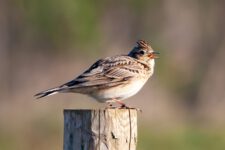
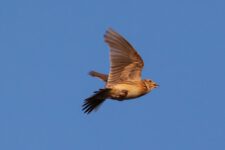
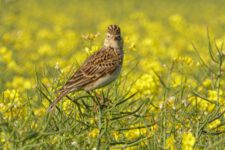
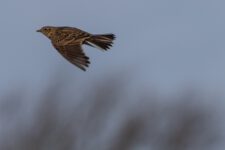
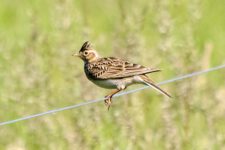
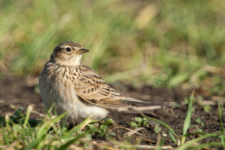
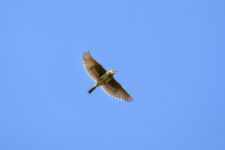
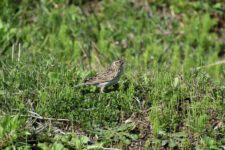
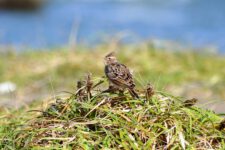
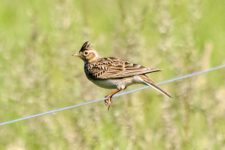

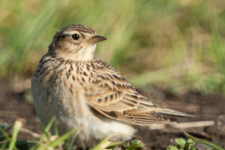
Fiche technique réalisée par Jean Claude Ricci directeur de l’IMPCF
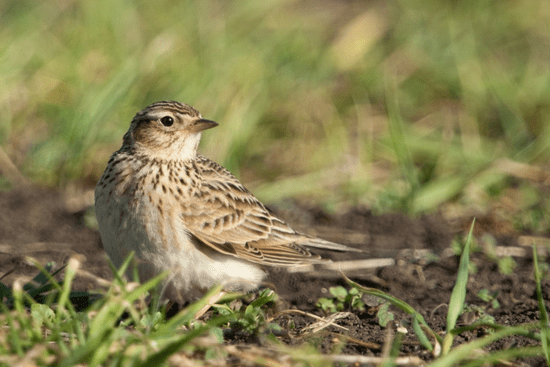
Photographié par : Wolfgang Kruk
Espèce : Alouette des champs / Alauda Arvensis
Nom anglais : Skylark Famille : Alaulidae
Taille : 16-18 cm
Envergure : 30-36 cm
Poids : 30-55 gr
Longévité : 8 ans
Aspect
Son corps est rondelet. Ses ailes sont assez longues, larges à la base et pointues. Sa queue est plutôt longue et légèrement échancrée. L’Alouette des champs possède une petite touffe de plumes érectiles formant une courte huppe assez large sur la tête. Le mâle peut dresser sa huppe. L’adulte est brun roussâtre ou brun-gris fortement strié de brun-noir sur le dos avec les sourcils blanchâtres. Son ventre est blanc-crème, lavé de fauve sur la poitrine et les flancs. Sa poitrine est nettement striée de brun-noir, sa queue est brune avec un liserai blanc sur les côtés. L’arrière de ses ailes est bordé de blanc. Son bec est court, assez mince et pointu. Il est brun foncé avec la base brun jaunâtre. Ses pattes sont brunes jaunâtre, plutôt courtes et fines. Son œil est noisette
( tiré de CRAMP 1988)
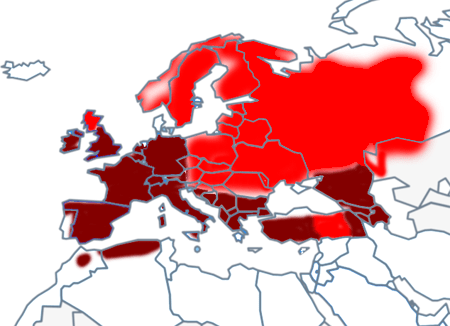
 : Présent toute l’année
: Présent toute l’année
 : Présent uniquement en période de reproduction
: Présent uniquement en période de reproduction
On trouve l’Alouette des champs de l’Afrique du Nord aux Iles Britanniques et à la Scandinavie. Son aire de répartition s’étend jusqu’à la Sibérie Orientale, le Moyen Orient et la Chine. Elle hiverne en Europe de l’Ouest et autour de la Méditerranée. En France, l’Alouette des champs hiverne sur l’ensemble du territoire national en dessous de 1000 m d’altitude. On la retrouve sur des terrains dégagés couverts d’une végétation herbacée dense. Elle est présente sur les zones agricoles, les prairies, les pâtures, les cultures de céréales, les champs labourés mais aussi sur les friches herbeuses et les dunes maritimes. L’Alouette des champs est en forte régression dans l’Europe du Nord-Ouest, par suite de la modification des pratiques culturales. On estime cette diminution à près de 50% de la population en un demi-siècle
Reproduction
En France, l’Alouette des champs se reproduit sur l’ensemble du territoire, du niveau de la mer jusqu’à 2700m d’altitude dans les Alpes. Sitôt la fin du mois de Mars, et surtout en Avril, débute sa période de reproduction. Voici les principales caractéristiques de la reproduction de l’Alouette des champs :
Nombre de couvaisons : deux à trois couvées, selon les couples,
Nombre d’œufs : 3 à 5 œufs blancs grisâtres fortement tachetés de brun d’olive,
Incubation : 11 à 14 jours (2 sexes)
Nid : Le nid est construit au sol à l’abri d’une plante herbacée. Il est constitué d’herbes sèches.
Envol : 20 jours
Emancipation : 25 jours environ
Taux de survie : 45,5 %
Migration
L’Alouette des champs migre le jour et la nuit. Le retour des migrateurs intervient à partir de début Février, lorsque les conditions météorologiques sont plus clémentes. Ainsi, la migration prénuptiale débute le 1er ou le 4 Février en Alsace (DRONNEAU et FRAULI, 1990 ; 1991). Dans le Massif Central, la migration de retour s’amorce le 15 et le 23 Février pour se prolonger jusqu’au début de mars (BRUNET, 1988). Des passages ont encore lieu jusqu’au début d’avril. Il n’est pas exceptionnel qu’en cas d’importantes averses de neige, les migrateurs les plus précoces soient contraints d’effectuer une rétro migration. Ces mouvements de fuite peuvent être rapides et massifs.
La migration postnuptiale intervient, au plus tôt au cours de la seconde quinzaine de Septembre et ne devient très active qu’en octobre, pour s’achever vers la mi-novembre (YEATMAN, BERTHELOT&JARRY, 1994). Les populations du Nord de l’Europe migrent en automne vers la Péninsule Ibérique et le Maghreb.
CRAMP (1988) situe la migration postnuptiale de l’Alouette des champs entre Septembre (nord de l’Europe) et Novembre (sud de l’Europe), avec un pic de passage dans le nord de l’Europe la première quinzaine d’Octobre. Il situe la migration de retour entre Janvier (pour le sud de l’Europe) et Mars (pour le nord de l’Europe), avec un pic de passage en Février.













